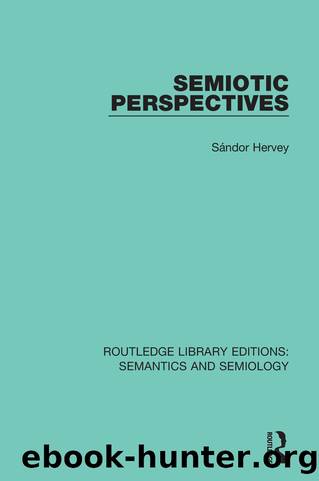Semiotic Perspectives by Sándor Hervey

Author:Sándor Hervey
Language: eng
Format: epub
Publisher: Routledge
5.5 Paradoxes of the 'Myth'
Barthes is definitely at his best, and most obviously in his element, when exposing the way that the signification of certain objects reflects 'myths' harboured in the unspoken ideology of a given culture. To a layman's understanding, 'myth' probably means simply a belief in something fictional. For Barthes, however, a 'myth' is not a mere belief, but the embodiment of a belief in a form that subtly hints at its ideological content through its signification.
If we are to form a relatively clear idea of what Barthes understands by the term 'myth', we need, on the one hand, to consider some of Barthes' own examples, and, on the other hand, to take stock of the paradoxes that characterise the propagation of 'myths'. In each case, we should remember that it is not what objects serve to preserve 'myths' that matters (any object may do so, by 'semantisation'), but how objects preserve, or even create, 'myths'.
As a way of entering into the spirit of Barthesian 'mythology', it will be found extremely instructive to look at the particular case of 'photographic messages', especially of press photographs. While the example does not immediately involve the exposing of any particular 'myth', the extremely full discussion Barthes gives (Barthes, 1977) of the connotative/significative potential of photographic images will provide us with most of the main ingredients of 'myths' in general. Furthermore, what Barthes refers to as the 'photographic paradox' sheds light on, and epitomises, the 'myth'.
A press photograph is a vehicle of a message (signification) whose source of emission, channel of transmission and point of reception are readily identified. Emission, by the staff of a newspaper, and reception, by a reading public, are of sociological relevance; they are matters of determining motives and attitudes in a society. The photograph as such is an object of semiological interest; as it goes through its channel of transmission (which is the newspaper itself), it achieves a degree of structural autonomy as something separate both from its source of emission which it has left, and from its point of reception which will be its ultimate destination. It is at this in-between stage that the photograph becomes, for Barthes, an object of 'immanent' analysis; that is to say, at this point, one should be able to determine what is in the photograph itself, as opposed to what is in the motives or attitudes either of the newspaper staff who are its producers, or of the reading public who are its consumers. (There is a minor paradox here, in so far as the analyst cannot but become, himself, a point of reception – nor can he avoid attributing the messages he finds to some conscious/unconscious motives on the part of the source of emission.)
The central paradox of the photograph is that its content is by definition a literal reality: a photograph visually represents something, and does so in so far as physical/chemical processes enable it to record a concrete visual reality. Consequently, the relationship between photographic object and photographic image is not mediated by a code.
Download
This site does not store any files on its server. We only index and link to content provided by other sites. Please contact the content providers to delete copyright contents if any and email us, we'll remove relevant links or contents immediately.
Cecilia; Or, Memoirs of an Heiress — Volume 1 by Fanny Burney(32434)
Cecilia; Or, Memoirs of an Heiress — Volume 2 by Fanny Burney(31871)
Cecilia; Or, Memoirs of an Heiress — Volume 3 by Fanny Burney(31854)
The Lost Art of Listening by Michael P. Nichols(7406)
Asking the Right Questions: A Guide to Critical Thinking by M. Neil Browne & Stuart M. Keeley(5635)
We Need to Talk by Celeste Headlee(5542)
On Writing A Memoir of the Craft by Stephen King(4863)
Dialogue by Robert McKee(4321)
Pre-Suasion: A Revolutionary Way to Influence and Persuade by Robert Cialdini(4149)
I Have Something to Say: Mastering the Art of Public Speaking in an Age of Disconnection by John Bowe(3840)
Elements of Style 2017 by Richard De A'Morelli(3307)
The Book of Human Emotions by Tiffany Watt Smith(3238)
Fluent Forever: How to Learn Any Language Fast and Never Forget It by Gabriel Wyner(3028)
Name Book, The: Over 10,000 Names--Their Meanings, Origins, and Spiritual Significance by Astoria Dorothy(2939)
Good Humor, Bad Taste: A Sociology of the Joke by Kuipers Giselinde(2903)
Why I Write by George Orwell(2874)
The Art Of Deception by Kevin Mitnick(2736)
The Grammaring Guide to English Grammar with Exercises by Péter Simon(2710)
Ancient Worlds by Michael Scott(2625)
